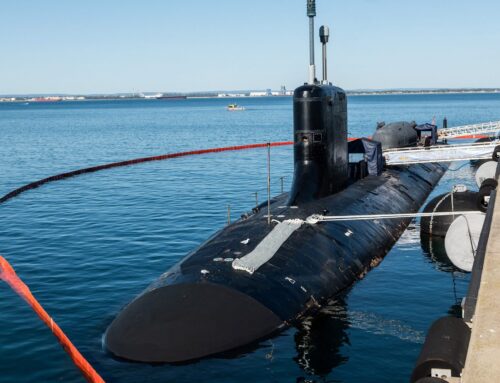
An early Glide Phase Interceptor design concept. (Missile Defense Agency)
On Nov. 21, Russia’s Vladimir Putin gave the West a clear window into his strategic thinking and intent. By using the “Oreshnik” missile against Ukraine — a weapon Putin claims is a “hypersonic” threat, although analysts are mixed — he not only demonstrated his willingness to use the advanced parts of his arsenal, but also the unprecedented capability they represent.
Afterwards, Putin bragged that the weapon is immune to missile defenses. Putting aside the question of whether this is a “true” hypersonic weapon, his broader point is correct: As of this moment, the US has no real defenses against a hypersonic threat.
Earlier this year, the Missile Defense Agency (MDA) was forced to an unfortunate decision regarding its Glide Phase Interceptor (GPI) program, which is supposed to provide America’s first defense against hypersonic glide vehicles. The reasons for and the consequences of that decision should serve as a cautionary tale for both the next Congress and incoming administration, especially if our country is to take serious weapons currently in the hands of adversaries like Mr. Putin.
In the past, MDA had touted its commitment to its own “best acquisition practices,” which included “fly before you buy” and extending corporate competition deeper into the acquisition process. However, GPI had an early “downselect” decision, picking one corporate contractor as the winner for the program and ending the competition.
The decision came five years earlier than planned, before even an evaluation of the competing teams’ Preliminary Design Reviews. This is highly unusual.
Lt. Gen. Heath Collins, the MDA Director, described the decision as “resource driven.” This is Pentagon code for when the Department of Defense is presented with an arbitrary top line budget number — devoid of study, analysis, or overarching strategy — and then forced to fit its entire spending under that ceiling. In a recent interview, Collins stated, “As we came into [FY] 25, the Fiscal Responsibility Act … put pressure on the entire department to make really tough prioritization and resource-informed decisions.”
For GPI, a highly probable consequence of this early downselect decision is an unpredictable funding stream for the program. This, compounded with its relative programmatic immaturity and the potential for developmental challenges, raises concern about when the warfighter can expect GPI’s capability in their hands. As Masao Dahlgren from the Center for Strategic and International Studies has stated, “downselecting so early in the development process adds risk — if any delays come up, there won’t be a competing design to choose.”
Remember, there is no predecessor for GPI. It represents the first and only interceptor envisioned and designed specifically to counter Russian and Chinese hypersonic glide vehicles. Like Oreshnik, these weapons are already fielded, and yet the US currently still has no realistic hypersonic defense.
GPI will not operate in a vacuum but requires a space-based sensing and tracking capability to acquire and track the hypersonic weapon, and then cue GPI to perform an intercept and destroy the weapon. Due to the physics involved with the problem set, Collins has stressed the need for an orbital detection and tracking capability to cue GPI, “so instead of being down looking up to find a hypersonic, you really want to be high looking down to track hypersonics.”
This effort is currently represented by the Hypersonic and Ballistic Tracking Space Sensor (HBTSS) satellite capability, two of which were launched into orbit this past February. To ensure full and complete compatibility between the interceptor and the sensing and tracking system, these capabilities must be developed in parallel, so as to inform the design and final configuration of both.
In the 2024 National Defense Authorization Act, Congress mandated an early, terminal phase initial operating capability against hypersonics be provided by 2029. This interim solution is prudent, but this initial rudimentary system — aptly termed a “gap-filler” — must not be allowed to compete for budget with the fully operationally capable GPI vehicle required by 2032. Two distinct and adequate funding streams are essential.
Back in April 2023, Rep. Doug Lamborn, Chairman of the House Strategic Forces Subcommittee, spoke to the importance of these programs when he said, “Given the rapid pace with which our adversaries are pursuing and fielding hypersonic systems, I am eager to hear ideas from DoD on how to pull both HBTSS and GPI to the left.” While that may no longer be possible given the fiscal realities forced upon MDA, Lamborn’s sentiments certainly describe the absolute need not to allow either program to languish.
The incoming Trump administration has already signaled its desire to re-prioritize missile defense in a way the current Biden administration has not. Congress should make common cause with the new administration and breathe new life into missile defense of the homeland and forward-deployed US assets by providing a stabilized and predictable funding stream for GPI. The budget should be adequate for development and testing, and be resilient enough to weather the inevitable challenges any new program will encounter.
Sufficient funding is the key to securing an acquisition timeline to field a fully operationally capable GPI by 2032. The stakes are indeed very high, and if Mr. Putin has shown us anything, it is that there is no time to waste.
Major General Howard “Dallas” Thompson (US Air Force – ret.) is a former Chief of Staff at NORAD and NORTHCOM.










